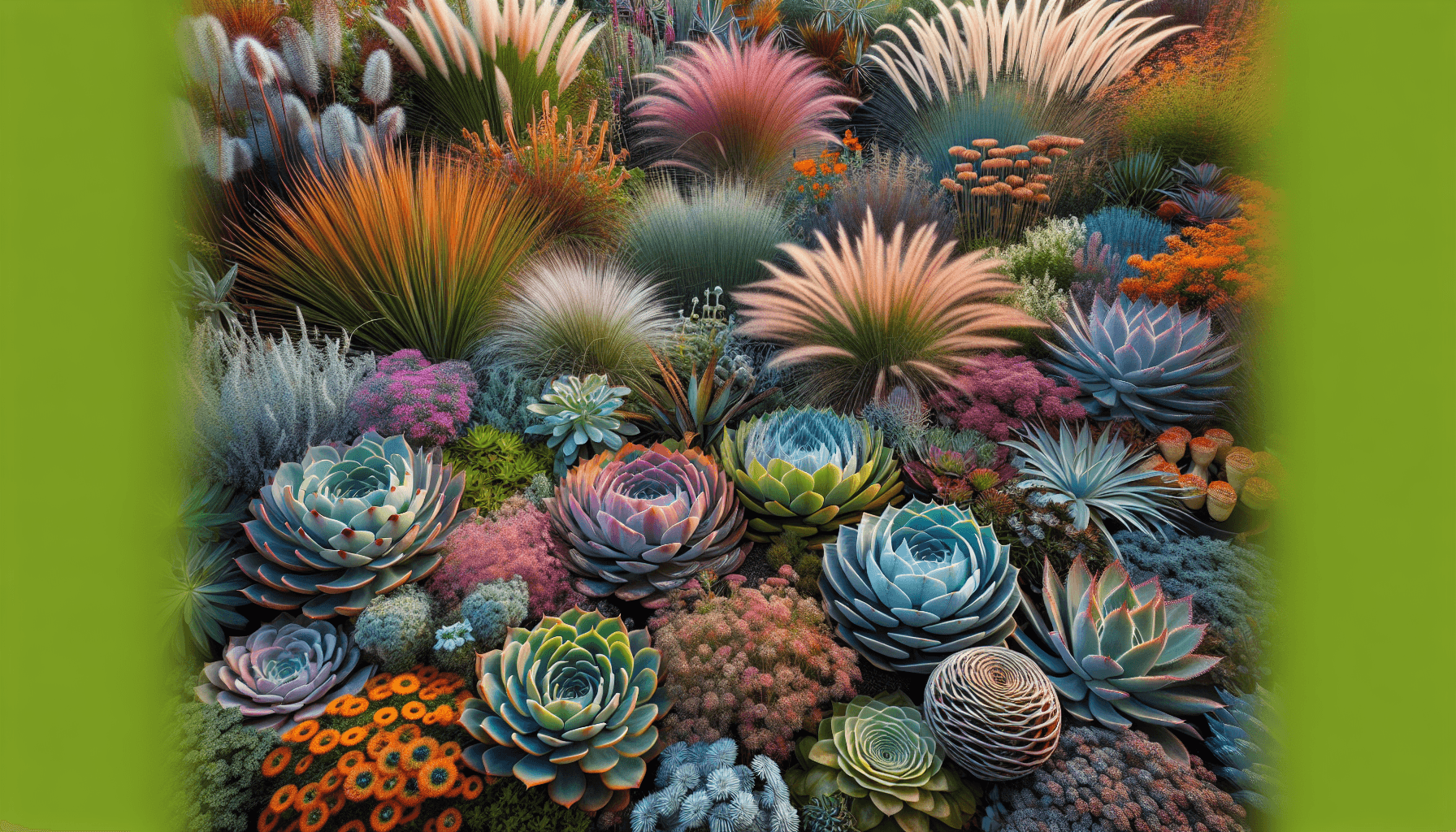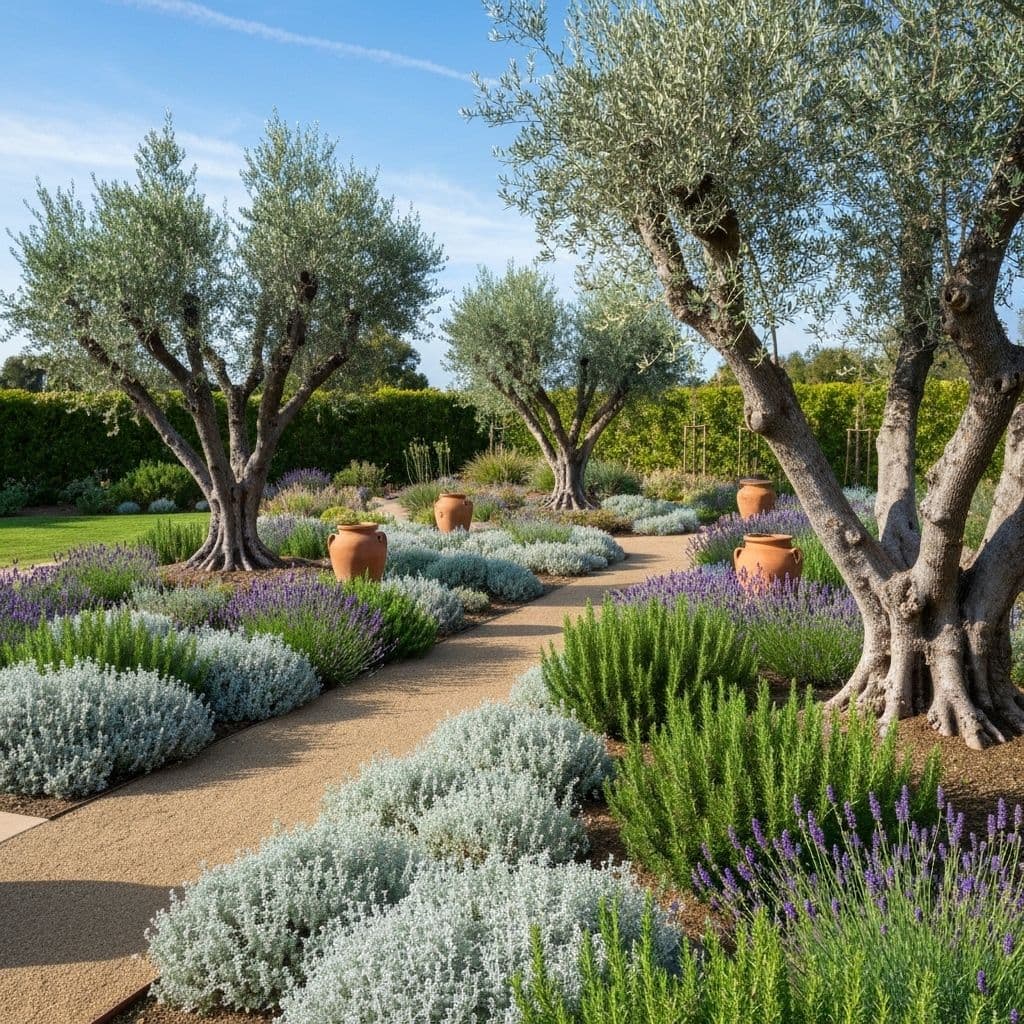California's ongoing water challenges require smart plant choices that deliver beauty without the water bill. Whether you're dealing with a hot, dry slope, heavy clay soil, or deep shade under existing trees, there are proven drought-tolerant solutions that thrive in these challenging conditions.
This guide is organized by the specific problems you're likely facing in your garden. Each section offers tested plant solutions that not only survive but flourish with minimal water once established, creating beautiful, resilient landscapes perfectly suited to California's climate.
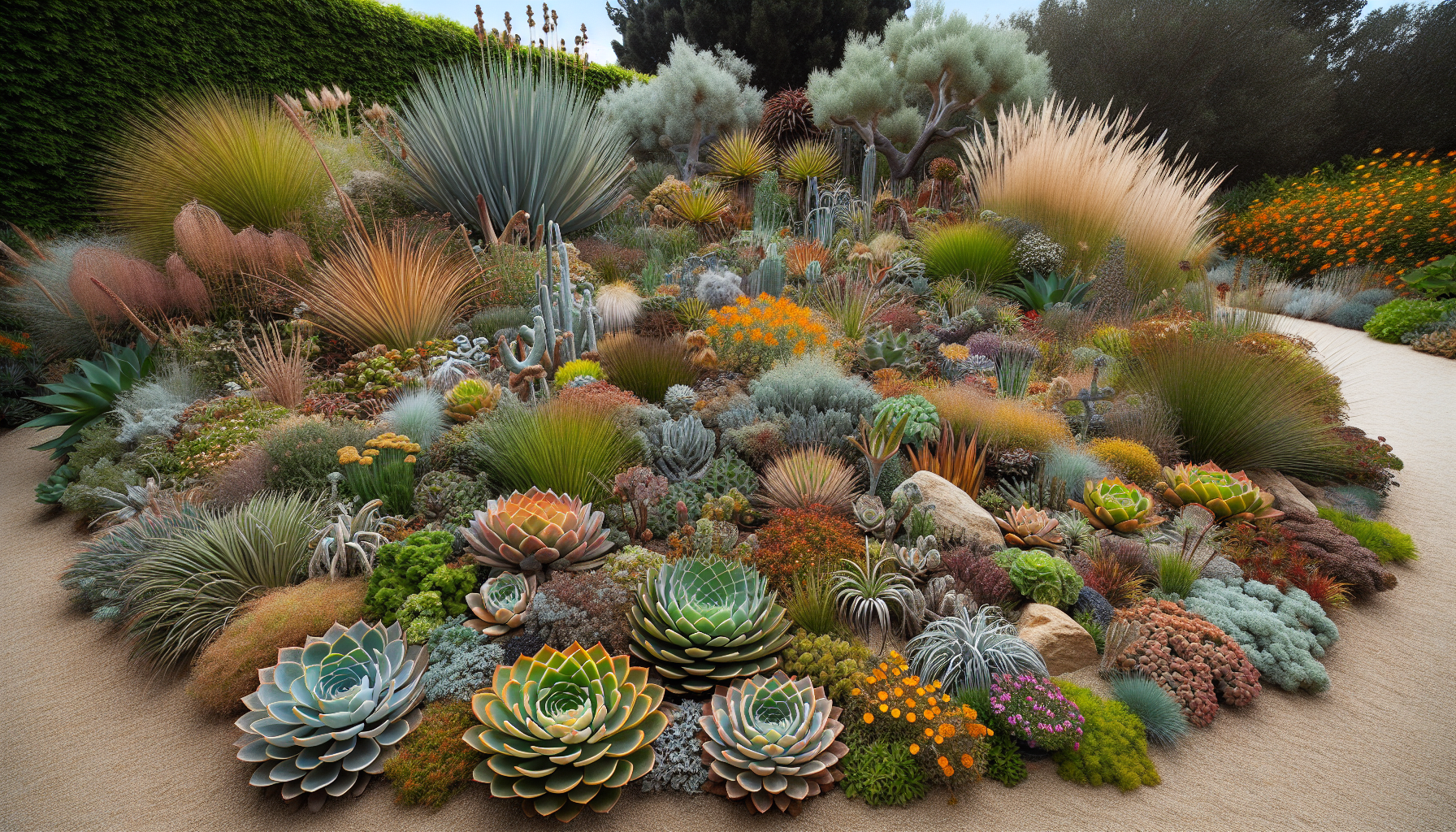
A diverse palette of drought-tolerant plants creates year-round interest with minimal water
For Hot, Dry Slopes That Are Hard to Water
Problem: Steep areas that dry out quickly and are difficult to maintain
Slopes present unique challenges—they shed water quickly, are difficult to access for maintenance, and often have shallow, poor-quality soil. The solution is ground-hugging spreaders with extensive root systems that prevent erosion while creating beautiful, low-maintenance coverage.

Ground-hugging spreaders provide erosion control and beauty on challenging slopes
Solution: Ground-Hugging Spreaders
Ceanothus 'Yankee Point' (Point Reyes Ceanothus)
Growth: 2-3 feet tall, 8-10 feet wide
Zones: 8-10
Benefits: Dense mat prevents erosion, stunning blue flowers in spring, tolerates poor soil
Care: Plant in fall, water first year only, never fertilize
Arctostaphylos 'Pacific Mist' (Manzanita)
Growth: 1-2 feet tall, 6-8 feet wide
Zones: 8-10
Benefits: Silver-blue foliage, pink flowers, excellent erosion control
Care: Requires excellent drainage, drought tolerant once established
Baccharis pilularis 'Twin Peaks' (Dwarf Coyote Brush)
Growth: 1-2 feet tall, 6-8 feet wide
Zones: 8-10
Benefits: Extremely tough, green year-round, native wildlife plant
Care: Zero maintenance once established, shear annually for dense growth
For Clay Soil That Stays Wet in Winter
Problem: Heavy clay that creates soggy conditions but bakes hard in summer
Clay soil is one of California's most common challenges. It retains water in winter, creating potential root rot issues, then cracks and becomes rock-hard in summer. The key is selecting plants naturally adapted to these seasonal extremes—typically California natives that evolved in foothill and valley conditions.
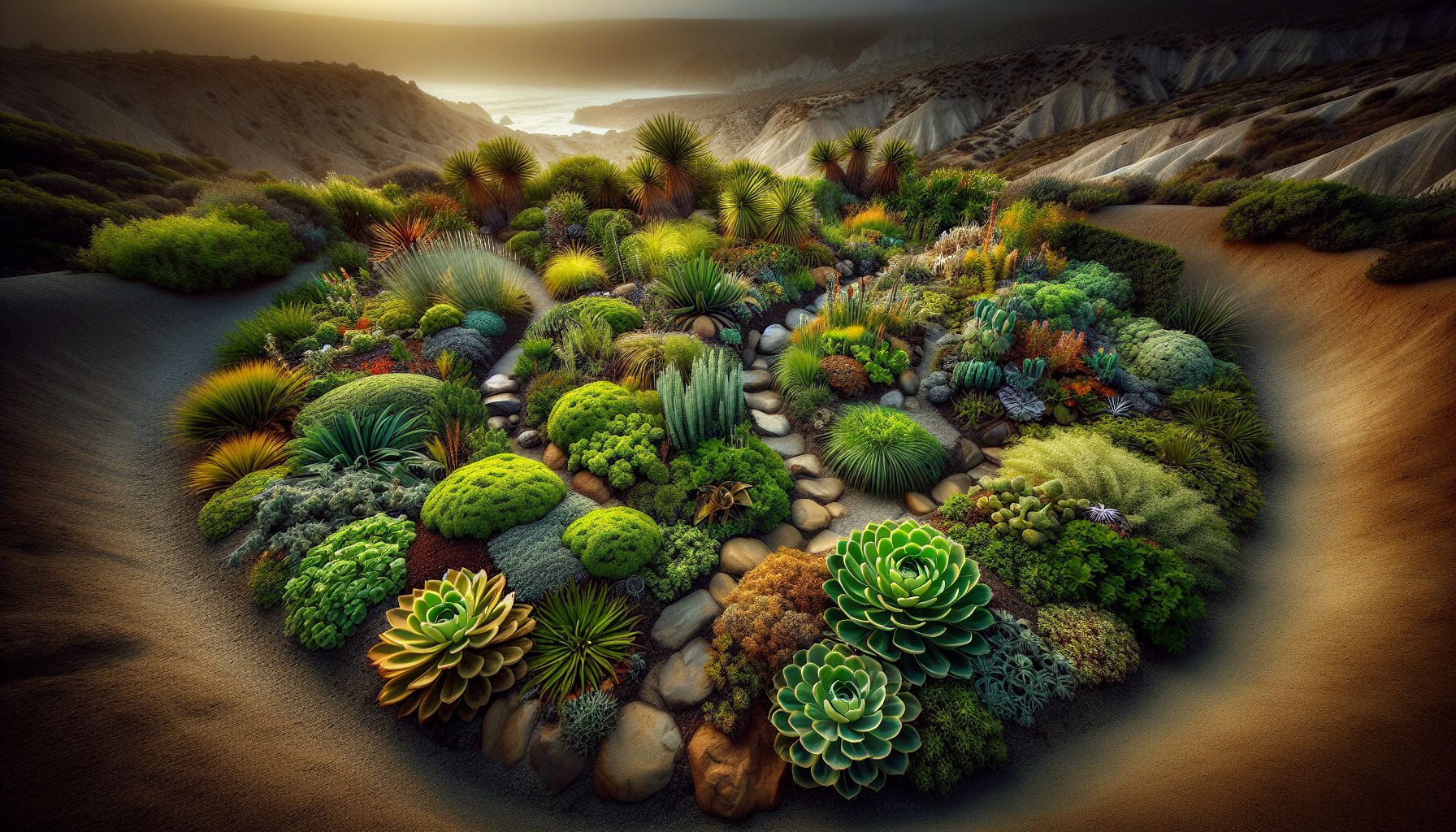
Native plants adapted to clay soil handle both winter wet and summer dry conditions
Solution: Plants That Handle Both Extremes
Heteromeles arbutifolia (Toyon)
Growth: 8-25 feet tall and wide
Zones: 8-10
Benefits: Red berries for birds, evergreen, tolerates clay
Care: Plant on slight mound for drainage, prune in late winter
Quercus agrifolia (Coast Live Oak)
Growth: 20-70 feet tall and wide
Zones: 9-10
Benefits: Shade tree, supports 200+ insect species, extremely long-lived
Care: Never water after establishment, protect root zone from compaction
Rhamnus californica 'Eve Case' (California Coffeeberry)
Growth: 4-6 feet tall and wide
Zones: 8-10
Benefits: Berries change from green to red to black, bird magnet
Care: Tolerates clay, deer resistant, low water needs
For Areas with Reflected Heat
Problem: Intense heat and light that burns most plants
South-facing walls, driveways, and patios create microenvironments with extreme heat and reflected light. Many plants wilt and burn in these conditions. The solution is heat-loving Mediterranean and desert plants that have evolved adaptations like silvery foliage, waxy coatings, and the ability to thrive in full sun with minimal water.
Solution: Heat-Loving Mediterranean and Desert Plants
Penstemon 'Firebird' (Beardtongue)
Growth: 18-24 inches tall and wide
Zones: 8-10
Benefits: Orange-red flowers attract hummingbirds, blooms spring through fall
Care: Cut back by half in late winter, very drought tolerant
Salvia 'Bee's Bliss' (Sage)
Growth: 1-2 feet tall, 4-8 feet wide
Zones: 8-10
Benefits: Purple flowers, aromatic foliage, excellent groundcover
Care: Shear after flowering, never overwater
Agave attenuata (Foxtail Agave)
Growth: 3-4 feet tall and wide
Zones: 9-11
Benefits: Sculptural form, no thorns, dramatic flower spike
Care: Water deeply but infrequently, protect from frost
For Shady Areas Under Trees
Problem: Dry shade with root competition
Dry shade is one of the most challenging garden conditions. The area under established trees receives little light and even less water, as tree roots monopolize moisture. Traditional shade plants that require consistent moisture fail here. The solution is shade-tolerant California natives that evolved in oak woodlands and can coexist with tree roots.
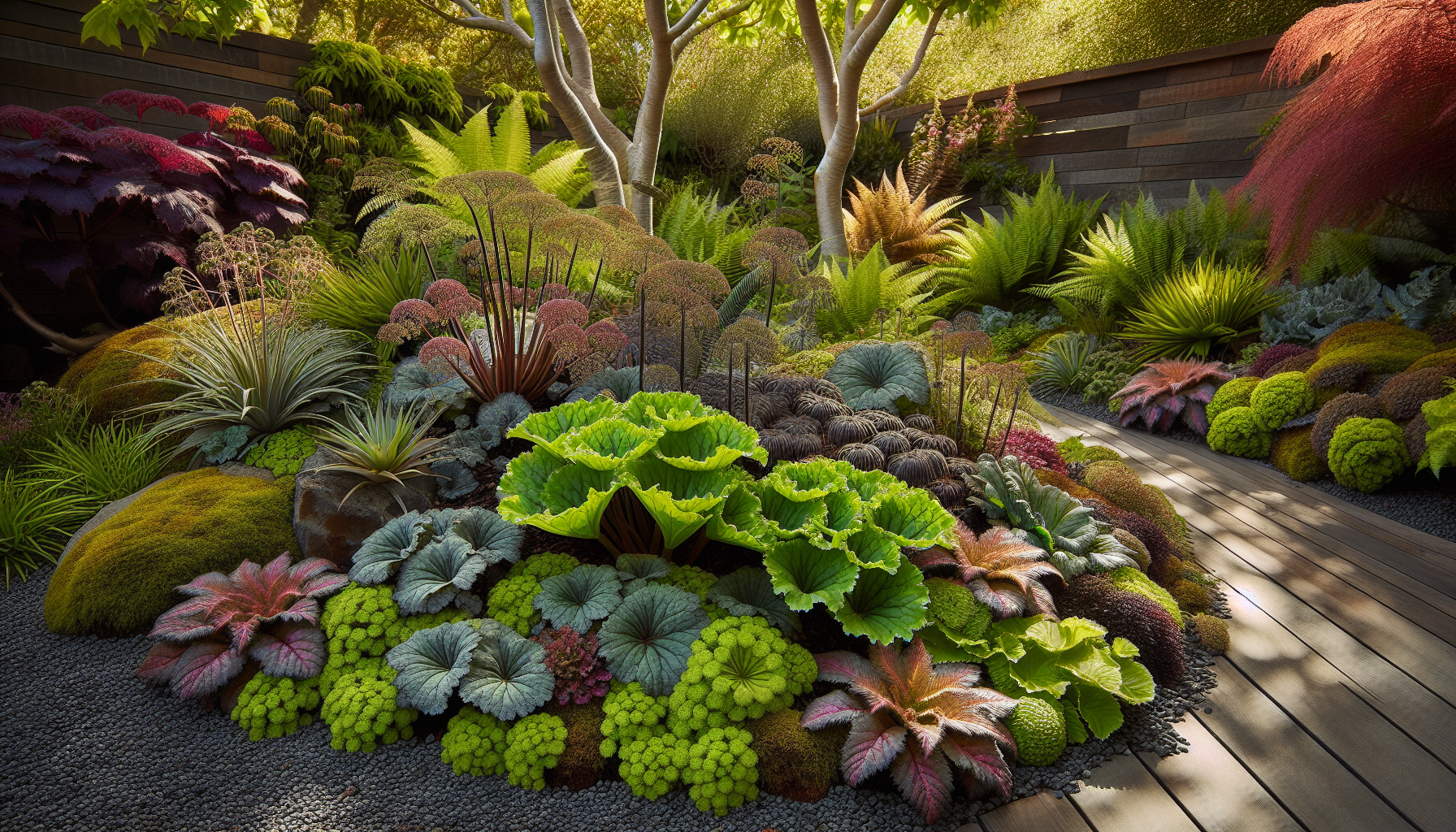
Shade-tolerant natives thrive under tree canopies with minimal water
Solution: Shade-Tolerant Natives
Heuchera maxima (Island Coral Bells)
Growth: 12-18 inches tall and wide
Zones: 8-10
Benefits: Evergreen foliage, delicate flower spikes, tolerates deep shade
Care: Mulch well, occasional summer water
Carex pansa (Pacific Dune Sedge)
Growth: 6-8 inches tall, spreads slowly
Zones: 8-10
Benefits: Lawn alternative, soft texture, handles foot traffic
Care: Water until established, then drought tolerant
Ribes sanguineum (Red Flowering Currant)
Growth: 4-8 feet tall and wide
Zones: 6-10
Benefits: Pink flowers in early spring, attracts hummingbirds
Care: Deciduous, prune after flowering, tolerates dry shade
For Creating Privacy Without High Water Use
Problem: Need screening plants that don't require constant irrigation
Traditional privacy hedges like privet and photinia are water-intensive and require frequent maintenance. Drought-tolerant screening plants offer a better solution—fast-growing, dense coverage that establishes quickly, then thrives on minimal water. Many also provide seasonal interest with flowers or fragrance.
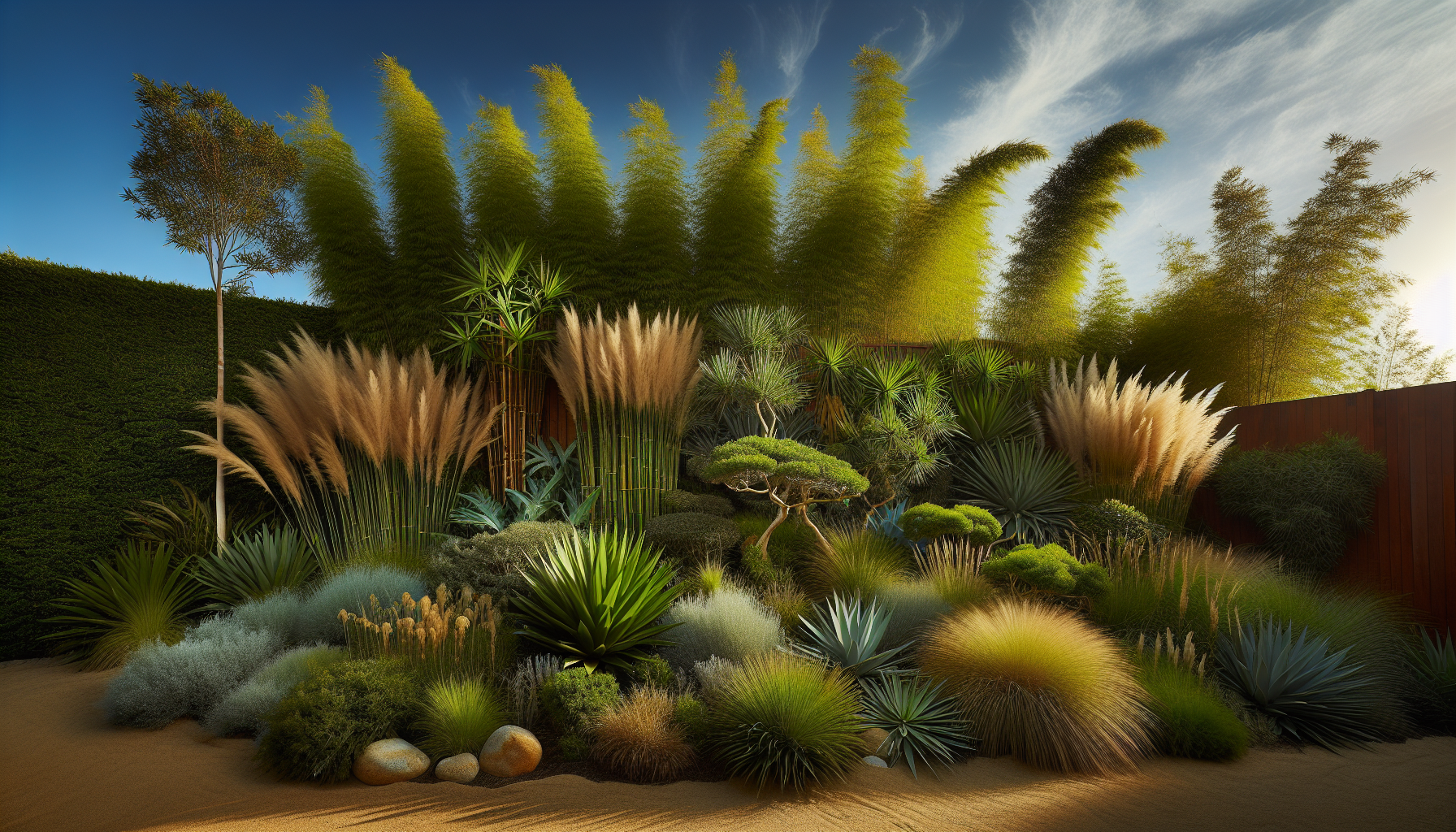
Fast-growing, drought-tolerant plants create effective privacy screens
Solution: Fast-Growing, Dense Natives and Mediterranean Plants
Ceanothus 'Ray Hartman' (California Lilac)
Growth: 12-20 feet tall, 12-15 feet wide
Zones: 8-10
Benefits: Fast growth, blue flowers, can be pruned as hedge
Care: Plant in fall, water first two years, then drought tolerant
Laurus nobilis (Bay Laurel)
Growth: 12-40 feet tall, 8-25 feet wide
Zones: 8-10
Benefits: Aromatic leaves for cooking, dense screening, evergreen
Care: Tolerates pruning, moderate water needs
Pittosporum tobira (Japanese Mock Orange)
Growth: 8-15 feet tall and wide
Zones: 8-10
Benefits: Dense growth, fragrant flowers, salt tolerant
Care: Drought tolerant once established, prune to shape
Adding Color with Drought-Tolerant Perennials
While structural plants form the backbone of your drought-tolerant garden, flowering perennials add seasonal color and visual interest. These tough plants deliver vibrant blooms without demanding constant irrigation, creating a dynamic landscape that changes throughout the year.

Drought-tolerant perennials provide seasonal color without high water demands
Spring Blooming
- Bearded Iris - Spectacular blooms in every color imaginable
- Penstemon - Tubular flowers attract hummingbirds
- Yarrow (Achillea) - Flat-topped flowers, excellent for cutting
- Euphorbia - Chartreuse bracts provide long-lasting color
Summer & Fall Interest
- Agapanthus - Blue or white spherical flowers on tall stalks
- Gaura - Delicate pink or white butterfly-like blooms
- Salvia - Hundreds of varieties in every color
- Russian Sage - Airy purple flowers and silvery foliage
Planting and Care Guidelines
Best Planting Times
Fall (October-December)
Ideal for all drought-tolerant plants. Natural rainfall helps establishment, and plants develop strong root systems before summer heat.
Early Spring (February-March)
Good for most plants, but requires summer watering assistance. Plants have less time to establish before the dry season.
Avoid Summer Planting
Unless you can provide consistent irrigation through the dry season. Heat stress makes establishment difficult.
Soil Preparation
For Clay Soil
Add coarse sand (not fine sand) and plant on 6-12 inch mounds for drainage. Avoid over-amending—many natives prefer heavier soil.
For Sandy Soil
Add a small amount of compost, but don't over-amend. Many drought plants prefer lean soil and will grow leggy with too many nutrients.
General Rule
Most drought-tolerant plants prefer soil that drains within 24 hours after watering. Test drainage before planting.
Watering Schedule for Establishment
Water 2-3 times per week, deeply but less frequently. Focus on deep watering that encourages root growth rather than shallow, frequent watering.
Reduce to once per week during dry season. Plants should be developing extensive root systems and requiring less surface irrigation.
Most plants will survive on rainfall alone, with occasional deep watering during extended drought. True drought tolerance has been achieved.
Common Mistakes to Avoid
Overwatering
More drought-tolerant plants die from too much water than too little. Soggy soil leads to root rot and fungal diseases.
Over-Fertilizing
Most drought plants prefer poor soil and will grow too fast and weak with fertilizer. Avoid feeding unless plants show deficiency symptoms.
Wrong Pruning Timing
Don't prune most California natives in summer. Wait until fall or early winter when plants enter their active growth period.
Impatience
Many drought plants look sparse the first year while establishing deep roots. Trust the process—they'll fill out in year two.
Regional Considerations
Coastal Areas (Zones 9-10)
Focus on salt-tolerant plants like Baccharis, Pittosporum, and Agave. Expect slower growth due to cool temperatures and fog. Humidity can benefit some drought plants but may encourage fungal issues in others.
Inland Valleys (Zones 8-9)
Choose plants rated for more extreme temperatures. Provide afternoon shade for marginal plants. Heat-lovers like Salvia and Penstemon thrive here with minimal care.
Foothill Areas (Zones 7-9)
Select cold-hardy varieties that can handle occasional frost. Watch for frost pockets and ensure good air circulation. Many California natives evolved in these conditions and are perfectly adapted.
Seasonal Maintenance Calendar
Fall (September-November)
- Best time for planting new drought-tolerant plants
- Reduce watering frequency as temperatures drop
- Light pruning of overgrown or wayward plants
- Prepare garden beds for winter rains
Winter (December-February)
- Minimal watering needed—rely on natural rainfall
- Plan new plantings and order plants
- Prune deciduous plants while dormant
- Enjoy the garden's evergreen structure
Spring (March-May)
- Enjoy peak bloom time for most drought-tolerant plants
- Light pruning after flowering to maintain shape
- Begin increasing water for first-year plants
- Deadhead spent blooms to encourage rebloom
Summer (June-August)
- Deep, infrequent watering for establishing plants
- Established plants require little to no water
- Deadhead spent flowers for tidiness
- Avoid heavy pruning during heat
The Path to a Water-Wise Garden
Success with drought-tolerant plants comes from matching the right plant to your specific conditions and resisting the urge to overcare for them. Whether you're tackling a hot slope, heavy clay soil, or dry shade, there are proven solutions that will thrive with minimal intervention.
Once established, these plants will reward you with years of low-maintenance beauty, reduced water bills, and the satisfaction of gardening in harmony with California's climate. Start with one problem area, choose plants suited to those conditions, and let nature do the rest. Your drought-tolerant garden will become more beautiful and more resilient with each passing year.
Topics
Click any topic to explore related articles
